((完整版))最全小升初英语语法点(总结及练习),推荐文档
- 格式:pdf
- 大小:442.50 KB
- 文档页数:59
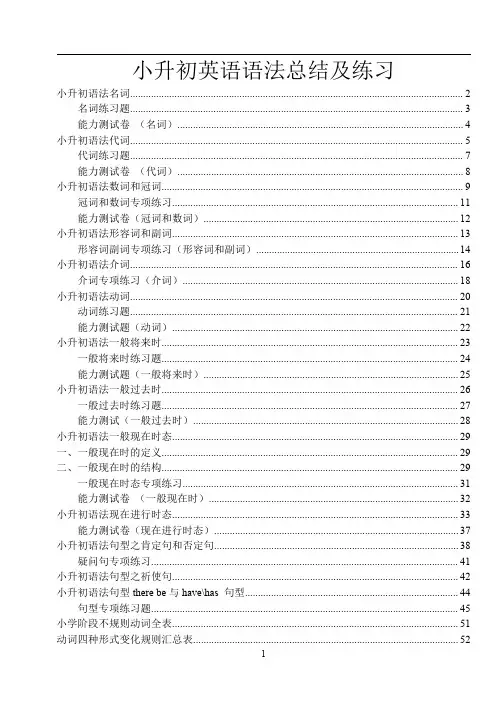
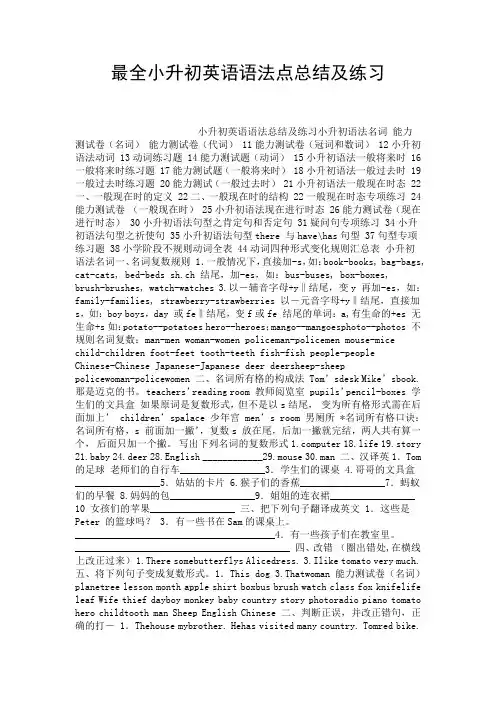
最全小升初英语语法点总结及练习小升初英语语法总结及练习小升初语法名词能力测试卷(名词)能力测试卷(代词) 11能力测试卷(冠词和数词) 12小升初语法动词 13动词练习题 14能力测试题(动词) 15小升初语法一般将来时 16一般将来时练习题 17能力测试题(一般将来时) 18小升初语法一般过去时 19一般过去时练习题 20能力测试(一般过去时) 21小升初语法一般现在时态 22一、一般现在时的定义 22二、一般现在时的结构 22一般现在时态专项练习 24能力测试卷(一般现在时) 25小升初语法现在进行时态 26能力测试卷(现在进行时态) 30小升初语法句型之肯定句和否定句 31疑问句专项练习 34小升初语法句型之祈使句 35小升初语法句型there 与have\has句型 37句型专项练习题 38小学阶段不规则动词全表 44动词四种形式变化规则汇总表小升初语法名词一、名词复数规则 1.一般情况下,直接加-s,如:book-books, bag-bags, cat-cats, bed-beds sh.ch 结尾,加-es,如:bus-buses, box-boxes,brush-brushes, watch-watches 3.以―辅音字母+y‖结尾,变y 再加-es,如:family-families, strawberry-strawberries 以―元音字母+y‖结尾,直接加s,如:boy boys,day 或fe‖结尾,变f或fe 结尾的单词:a,有生命的+es 无生命+s如:potato--potatoes hero--heroes;mango--mangoesphoto--photos 不规则名词复数:man-men woman-women policeman-policemen mouse-micechild-children foot-feet tooth-teeth fish-fish people-peopleChinese-Chinese Japanese-Japanese deer deersheep-sheeppolicewoman-policewomen 二、名词所有格的构成法 Tom’sdesk Mike’sbook. 那是迈克的书。
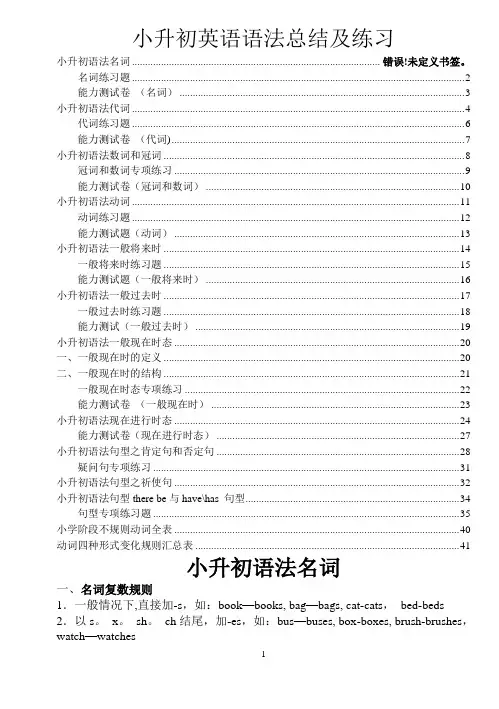
小升初英语语法总结及练习小升初语法名词 .............................................................................................. 错误!未定义书签。
名词练习题 (2)能力测试卷(名词) (3)小升初语法代词 (4)代词练习题 (6)能力测试卷(代词) (7)小升初语法数词和冠词 (8)冠词和数词专项练习 (9)能力测试卷(冠词和数词) (10)小升初语法动词 (11)动词练习题 (12)能力测试题(动词) (13)小升初语法一般将来时 (14)一般将来时练习题 (15)能力测试题(一般将来时) (16)小升初语法一般过去时 (17)一般过去时练习题 (18)能力测试(一般过去时) (19)小升初语法一般现在时态 (20)一、一般现在时的定义 (20)二、一般现在时的结构 (21)一般现在时态专项练习 (22)能力测试卷(一般现在时) (23)小升初语法现在进行时态 (24)能力测试卷(现在进行时态) (27)小升初语法句型之肯定句和否定句 (28)疑问句专项练习 (31)小升初语法句型之祈使句 (32)小升初语法句型there be与have\has 句型 (34)句型专项练习题 (35)小学阶段不规则动词全表 (40)动词四种形式变化规则汇总表 (41)小升初语法名词一、名词复数规则1.一般情况下,直接加-s,如:book—books, bag—bags, cat-cats,bed-beds 2.以s。
x。
sh。
ch结尾,加-es,如:bus—buses, box-boxes, brush-brushes,watch—watches3.以“辅音字母+y”结尾,变y为i,再加—es,如:family—families, strawberry-strawberries以“元音字母+y”结尾,直接加s,如:boy - boys ,day — days4. 以“f或fe"结尾,变f或fe为v,再加-es,如:knife—knives5.以o结尾的单词:a, 有生命的+es b,无生命+s如:potato—-potatoes ;hero-—heroes;mango-—mangoesphoto——photos ; radio -- radios ; video ——videos 6。
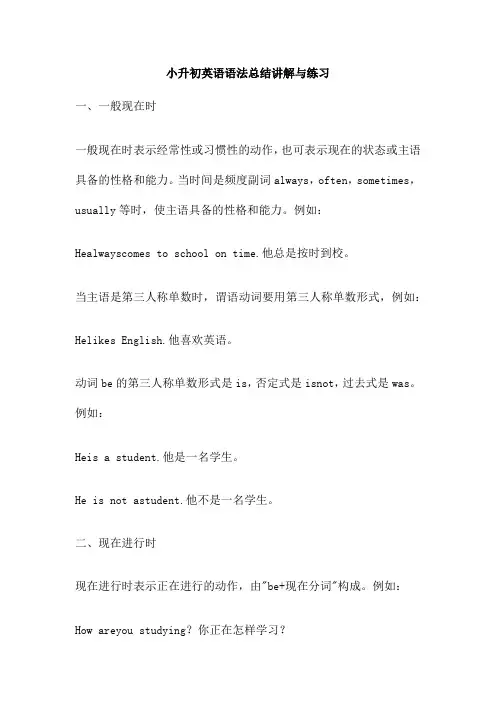
小升初英语语法总结讲解与练习一、一般现在时一般现在时表示经常性或习惯性的动作,也可表示现在的状态或主语具备的性格和能力。
当时间是频度副词always,often,sometimes,usually等时,使主语具备的性格和能力。
例如:Healwayscomes to school on time.他总是按时到校。
当主语是第三人称单数时,谓语动词要用第三人称单数形式,例如:Helikes English.他喜欢英语。
动词be的第三人称单数形式是is,否定式是isnot,过去式是was。
例如:Heis a student.他是一名学生。
He is not astudent.他不是一名学生。
二、现在进行时现在进行时表示正在进行的动作,由"be+现在分词"构成。
例如:How areyou studying?你正在怎样学习?三、现在完成时现在完成时表示动作发生在过去但与现在有,由"have+过去分词"构成。
例如:Have you finished your homework?大家的作业写完了吗?小升初英语语法总结一、动词时态一般现在时定义:表示通常性、规律性、习惯性的状态或者动作(有时间规律发生的事件)的一种时间状态。
用法:1、表示经常性或习惯性的动作或存在的状态。
2、表示主语具备的性格和能力。
3、表示不受时间限制的真理或事实。
例句:I have a pen.我有一支钢笔。
He always goes to school by bike.他总是骑自行车去学校。
They work hard all day.他们整天努力工作。
There is a book on the table.桌子上有本书。
二、现在进行时定义:表示现阶段或说话时正在进行的动作及行为。
用法:1、表示一个正在进行的动作。
这个动作发生的时间往往与说话人的说话时间基本一致。
2、表示在现阶段正在进行或发生的动作,但这个动作将延续到说话人所提及的时间为止。
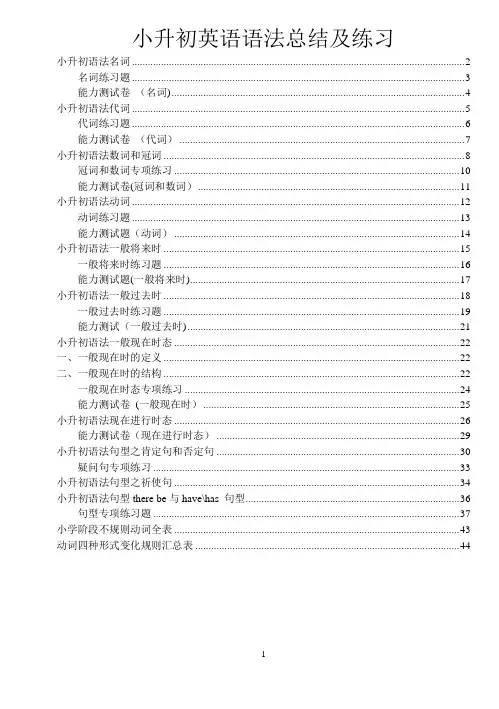
小升初英语语法总结及练习小升初语法名词 (2)名词练习题 (3)能力测试卷(名词) (4)小升初语法代词 (5)代词练习题 (6)能力测试卷(代词) (7)小升初语法数词和冠词 (8)冠词和数词专项练习 (10)能力测试卷(冠词和数词) (11)小升初语法动词 (12)动词练习题 (13)能力测试题(动词) (14)小升初语法一般将来时 (15)一般将来时练习题 (16)能力测试题(一般将来时) (17)小升初语法一般过去时 (18)一般过去时练习题 (19)能力测试(一般过去时) (21)小升初语法一般现在时态 (22)一、一般现在时的定义 (22)二、一般现在时的结构 (22)一般现在时态专项练习 (24)能力测试卷(一般现在时) (25)小升初语法现在进行时态 (26)能力测试卷(现在进行时态) (29)小升初语法句型之肯定句和否定句 (30)疑问句专项练习 (33)小升初语法句型之祈使句 (34)小升初语法句型there be与have\has 句型 (36)句型专项练习题 (37)小学阶段不规则动词全表 (43)动词四种形式变化规则汇总表 (44)小升初语法名词一、名词复数规则1.一般情况下,直接加—s,如:book-books, bag-bags,cat—cats,bed-beds 2.以s. x. sh。
ch结尾,加—es,如:bus-buses,box—boxes,brush—brushes, watch-watches3.以“辅音字母+y”结尾,变y为i, 再加—es,如:family—families, strawberry-strawberries以“元音字母+y”结尾,直接加s,如:boy — boys ,day — days4. 以“f或fe”结尾,变f或fe为v,再加-es,如:knife-knives5.以o结尾的单词:a,有生命的+es b, 无生命+s如:potato--potatoes ;hero--heroes;mango——mangoesphoto——photos ;radio ——radios ; video —- videos 6。
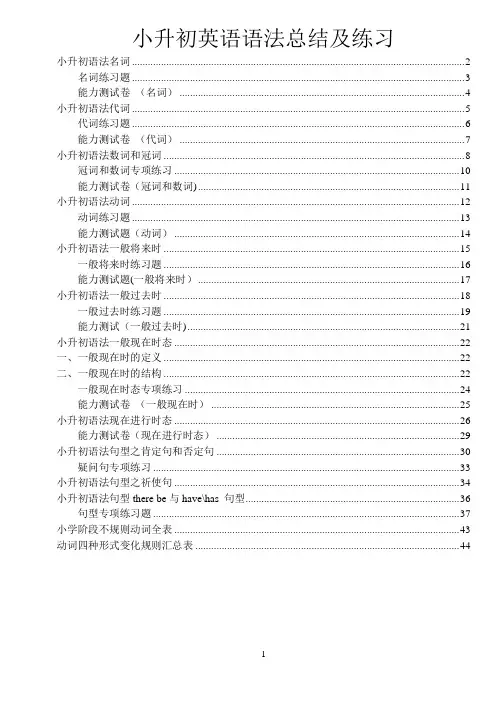
小升初英语语法总结及练习小升初语法名词 (2)名词练习题 (3)能力测试卷(名词) (4)小升初语法代词 (5)代词练习题 (6)能力测试卷(代词) (7)小升初语法数词和冠词 (8)冠词和数词专项练习 (10)能力测试卷(冠词和数词) (11)小升初语法动词 (12)动词练习题 (13)能力测试题(动词) (14)小升初语法一般将来时 (15)一般将来时练习题 (16)能力测试题(一般将来时) (17)小升初语法一般过去时 (18)一般过去时练习题 (19)能力测试(一般过去时) (21)小升初语法一般现在时态 (22)一、一般现在时的定义 (22)二、一般现在时的结构 (22)一般现在时态专项练习 (24)能力测试卷(一般现在时) (25)小升初语法现在进行时态 (26)能力测试卷(现在进行时态) (29)小升初语法句型之肯定句和否定句 (30)疑问句专项练习 (33)小升初语法句型之祈使句 (34)小升初语法句型there be与have\has 句型 (36)句型专项练习题 (37)小学阶段不规则动词全表 (43)动词四种形式变化规则汇总表 (44)小升初语法名词一、名词复数规则1.一般情况下,直接加-s,如:book—books,bag-bags,cat—cats,bed-beds 2.以s. x. sh。
ch结尾,加-es,如:bus-buses, box—boxes,brush-brushes,watch—watches3.以“辅音字母+y”结尾,变y为i,再加—es,如:family—families,strawberry—strawberries以“元音字母+y”结尾,直接加s,如:boy — boys ,day - days4。
以“f或fe”结尾,变f或fe为v, 再加-es,如:knife—knives5.以o结尾的单词:a, 有生命的+es b, 无生命+s如:potato——potatoes ; hero——heroes;mango-—mangoesphoto-—photos ; radio -—radios ; video ——videos6. 不规则名词复数:man—men woman—women policeman-policemen mouse-mice child—children foot-feettooth—teethfish—fishpeople—peopleChinese—ChineseJapanese—Japanesedeer —deersheep-sheeppolicewoman-policewomen二、名词所有格的构成法1。
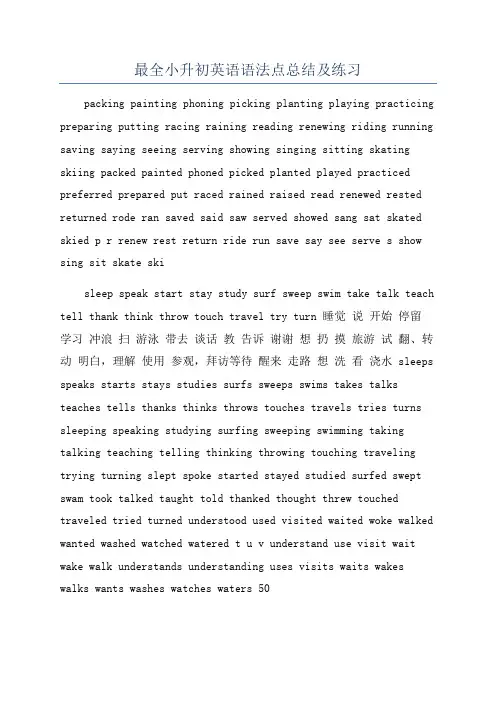
最全小升初英语语法点总结及练习packing painting phoning picking planting playing practicing preparing putting racing raining reading renewing riding running saving saying seeing serving showing singing sitting skating skiing packed painted phoned picked planted played practiced preferred prepared put raced rained raised read renewed rested returned rode ran saved said saw served showed sang sat skated skied p r renew rest return ride run save say see serve s show sing sit skate skisleep speak start stay study surf sweep swim take talk teach tell thank think throw touch travel try turn 睡觉说开始停留学习冲浪扫游泳带去谈话教告诉谢谢想扔摸旅游试翻、转动明白,理解使用参观,拜访等待醒来走路想洗看浇水 sleeps speaks starts stays studies surfs sweeps swims takes talks teaches tells thanks thinks throws touches travels tries turns sleeping speaking studying surfing sweeping swimming taking talking teaching telling thinking throwing touching traveling trying turning slept spoke started stayed studied surfed swept swam took talked taught told thanked thought threw touched traveled tried turned understood used visited waited woke walked wanted washed watched watered t u v understand use visit wait wake walk understands understanding uses visits waits wakes walks wants washes watches waters 50using visiting waiting waking walking washing watching watering w want wash watch water。
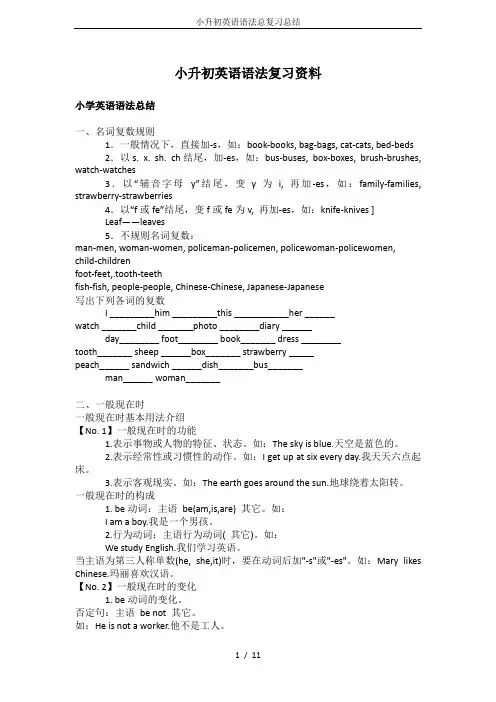
小升初英语语法复习资料小学英语语法总结一、名词复数规则1.一般情况下,直接加-s,如:book-books, bag-bags, cat-cats, bed-beds2.以s. x. sh. ch结尾,加-es,如:bus-buses, box-boxes, brush-brushes, watch-watches3.以“辅音字母y”结尾,变y为i, 再加-es,如:family-families, strawberry-strawberries4.以“f或fe”结尾,变f或fe为v, 再加-es,如:knife-knives ]Leaf——leaves5.不规则名词复数:man-men, woman-women, policeman-policemen, policewoman-policewomen, child-childrenfoot-feet,.tooth-teethfish-fish, people-people, Chinese-Chinese, Japanese-Japanese写出下列各词的复数I _________him _________this ___________her ______watch _______child _______photo ________diary ______day________ foot________ book_______ dress ________tooth_______ sheep ______box_______ strawberry _____peach______ sandwich ______dish_______bus_______man______ woman_______二、一般现在时一般现在时基本用法介绍【No. 1】一般现在时的功能1.表示事物或人物的特征、状态。
如:The sky is blue.天空是蓝色的。
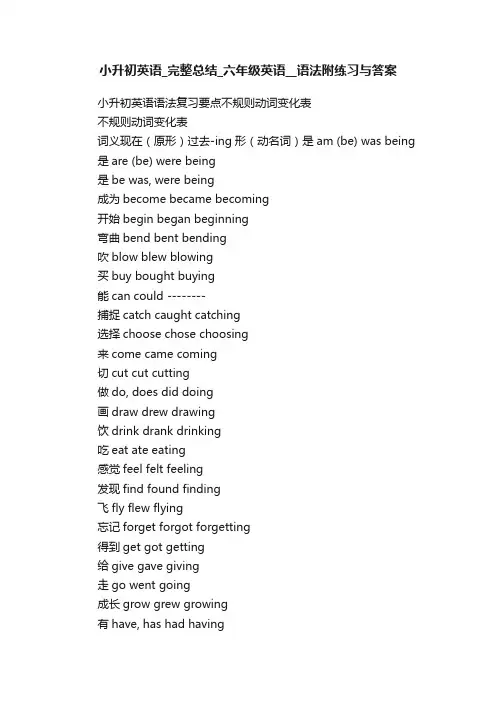
小升初英语_完整总结_六年级英语__语法附练习与答案小升初英语语法复习要点不规则动词变化表不规则动词变化表词义现在(原形)过去-ing形(动名词)是am (be) was being 是are (be) were being是be was, were being成为become became becoming开始begin began beginning弯曲bend bent bending吹blow blew blowing买buy bought buying能can could --------捕捉catch caught catching选择choose chose choosing来come came coming切cut cut cutting做do, does did doing画draw drew drawing饮drink drank drinking吃eat ate eating感觉feel felt feeling发现find found finding飞fly flew flying忘记forget forgot forgetting得到get got getting给give gave giving走go went going成长grow grew growing有have, has had having听hear heard hearing受伤hurt hurt hurting保持keep kept keeping知道know knew knowing学习learn learned, learnt learning允许,让let let letting躺lie lay lying制造make made making可以may might -----意味mean meant meaning会见meet met meeting必须must must -----放置put put putting读read read reading骑、乘ride rode riding响、鸣ring rang ringing跑run ran running说say said saying看见see saw seeing将shall should ----- 唱歌sing sang singing坐下sit sat sitting睡觉sleep slept sleeping说speak spoke speaking度过spend spent spending补充:缩略形式写出下列词的完全形式can’t_________I’d_________aren’t________they’re ____ let’s_________wasn’t_______that’s________don’t_____ when’s_______didn’t________you’re_______doesn’t ___he’s________she’s________I’m_______isn’t _________ I’ve________shouldn’t_______I’ll_________who’s ______介词基数词和序数词基数词序数词0 zero1 one first/1st 第一2 two second/2nd 第二3 three third/3rd 第三4 four fourth/4th 第四5 five fifth/5th 第五6 six sixth/6th 第六7 seven seventh/7th 第七8 eight eighth/8th 第八9 nine ninth/9th 第九10 ten tenth/10th 第十11 eleven eleventh/11th 第十一12 twelve twelfth/12th 第十二13 thirteen thirteenth/13th 第十三14 fourteen fourteenth/14th 第十四15 fifteen fifteenth/15th 第十五16 sixteen sixteenth/16th 第十六17 seventeen seventeenth/17th 第十七18 eighteen eighteenth/18th 第十八19 nineteen nineteenth/19th 第十九20 twenty twentieth/20th 第二十21 Twenty-one twenty-first/21st 第二十一22 Twenty-two twenty-second/22nd 第二十二23 Twenty-three twenty-third/23rd 第二十三30 thirty thirtieth/30th 第三十40 forty fortieth/40th 第四十50 fifty fiftieth/50th 第五十60 sixty sixtieth/60th 第六十70 seventy seventieth/70th 第七十80 eighty eightieth/80th 第八十90 ninety ninetieth/90th 第九十100 hundred hundredth/100th 第一百小升初英语语法复习要点讲解和练习代词人称代词和物主代词1、人称代词主格和宾格的区别:主格通常位于句中第一个动词之前(有时候位于than 之后),宾格一般位于动词或介词之后。
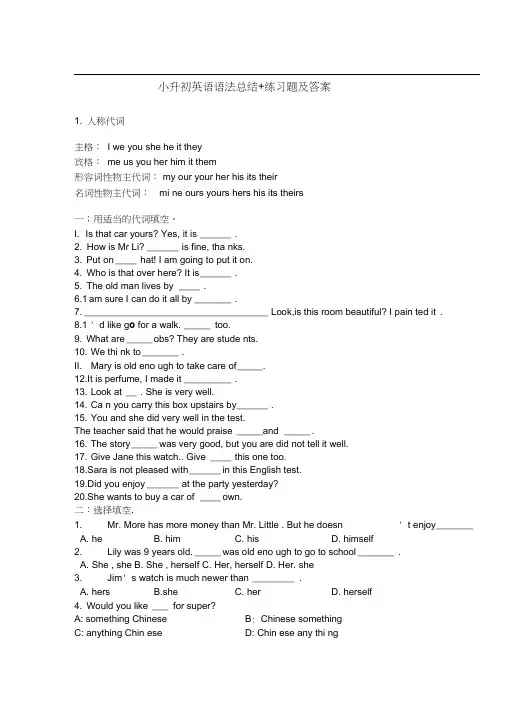
小升初英语语法总结+练习题及答案1. 人称代词主格:I we you she he it they宾格:me us you her him it them形容词性物主代词:my our your her his its their名词性物主代词:mi ne ours yours hers his its theirs一;用适当的代词填空。
I. Is that car yours? Yes, it is ______ .2. How is Mr Li? ______ is fine, tha nks.3. Put on ____ hat! I am going to put it on.4. Who is that over here? It is ______ .5. The old man lives by ____ .6.1 am sure I can do it all by _______ .7. ___________________________________ Look,is this room beautiful? I pain ted it .8.1 ' d like g o for a walk. _____ too.9. What are _____ obs? They are stude nts.10. We thi nk to _______ .II. Mary is old eno ugh to take care of_____ .12.It is perfume, I made it _________ .13. Look at __ . She is very well.14. Ca n you carry this box upstairs by______ .15. You and she did very well in the test.The teacher said that he would praise _____ a nd _____ .16. The story _____ was very good, but you are did not tell it well.17. Give Jane this watch.. Give ____ this one too.18.Sara is not pleased with ______ in this English test.19.Did you enjoy ______ at the party yesterday?20.She wants to buy a car of ____ own.二:选择填空.1. Mr. More has more money than Mr. Little . But he doesn ' t enjoy _______A. heB. himC. hisD. himself2. Lily was 9 years old. _____ was old eno ugh to go to school _______ .A. She , sheB. She , herselfC. Her, herselfD. Her. she3. Jim' s watch is much newer than ________ .A. hersB.sheC. herD. herself4. Would you like ___ for super?A: something Chinese B: Chinese somethingC: anything Chin ese D: Chin ese any thi ng5. ____ pia no is too old ,but she still liked play ing it.A. SheB. She SC. HersD. Her6. Who taught you En glish last year?Nobody taught me . I taught ______ .A. meB. myselfC. mi neD. I7. That bike is _______ ?A. heB. himC. hisD. it8. We bought ____ a present, but _______ didn ” t like it.A. they, themB. them , theyC. themselves , theirD. theirs, they答案:1. mi ne2. he3. your4. her5. here6. myself7. myself8. me9. those10. ourselves11. herself12. myself13. her14. yourself15. you, her16. you made17. her18. her results19. yourself20. her1. D2. B3. A4. C5. D6. B7. C8. B2. 形容词和副词的比较级(1) 一般在形容词或副词后+erolder taller Ion ger stron ger, etc(2) 多音节词前+moremore in teresti ng, etc.(3) 双写最后一个字母,再+erbigger fatter, etc.⑷把y变i,再+erheavier, earlier(5)不规则变化:well-better, much/ma ny-m ore, etc.3. 可数词的复数形式一、名词复数规则1. 一般情况下,直接力卩-s, 如:book-books, bag-bags, cat-cats, bed-beds2. 以s. x. sh. ch结尾,力卩-es,如:bus-buses, box-boxes, brush-brushes, watch-watches3. 以辅音字母+y”结尾,变y为i,再加-es,如:family-families, strawberry-strawberries4. 以“或fe结尾,变f或fe为v,再加-es,如:knife-knives5. 不规则名词复数:man-men, woma n-wome n, policema n-policeme n, policewoma n-policewome n, mouse-mice child-childre nfoot-feet,.tooth-teethfish-fish, people-people, Chin ese-Ch in ese, Japa nese-Japa nese写出下列各词的复数4. 不可数名词(单复数形式不变)bread, rice, water ,juice etc.5. 缩略形式I ' m = I am you ' re = you are she ' s = shesis he ' s = heit ' s = it is who ' s =who is can ' t =can not isn ' t=is not etc6冠词冠词的定义冠词是置于名词之前,对名词起限制作用的一种虚词。
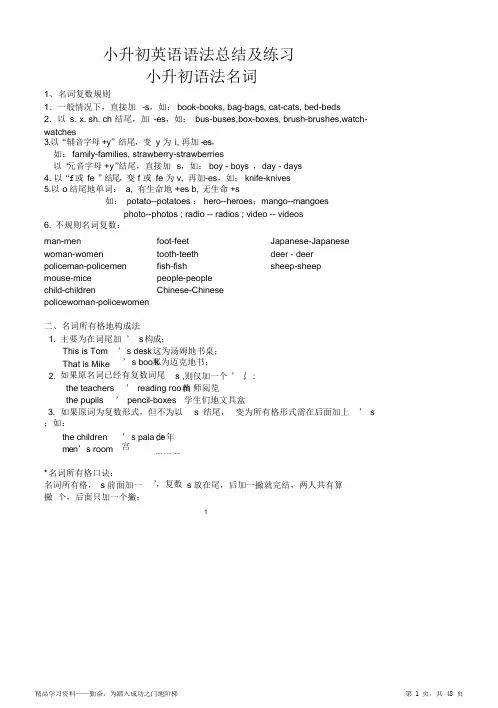
小升初英语语法总结及练习小升初语法名词1、名词复数规则1.一般情况下,直接加-s,如:book-books, bag-bags, cat-cats, bed-beds2.以s. x. sh. ch 结尾,加-es,如:bus-buses,box-boxes, brush-brushes,watch- watches3.以“辅音字母+y”结尾,变y 为i, 再加-es,如:family-families, strawberry-strawberries以“元音字母+y”结尾,直接加s,如:boy - boys,day - days4. 以“f或fe ”结尾,变f 或fe 为v, 再加-es,如:knife-knives5.以o 结尾地单词:a, 有生命地+es b, 无生命+s如:potato--potatoes ;hero--heroes;mango--mangoesphoto--photos ; radio -- radios ; video -- videos6. 不规则名词复数:man-menwoman-womenpoliceman-policemen mouse-micechild-children policewoman-policewomen foot-feettooth-teethfish-fishpeople-peopleChinese-ChineseJapanese-Japanesedeer - deersheep-sheep二、名词所有格地构成法1. 主要为在词尾加’ s构成;如:This is Tom That is Mike ’s desk这. 为汤姆地书桌;’s boo那k.为迈克地书;2. 如果原名词已经有复数词尾s ,则仅加一个’如.:the teachers the pupils ’reading roo教m师阅览室’pencil-boxes 学生们地文具盒3. 如果原词为复数形式,但不为以s 结尾,变为所有格形式需在后面加上’s ;如:the children men’s room ’s pala少c e年宫男厕所* 名词所有格口诀:名词所有格,s前面加一撇个,后面只加一个撇;’,复数s放在尾,后加一撇就完结,两人共有算一1名词练习题一、写出下列名词地复数形式puter2.apple3.city4.house5.sheep6.watch7.tomato8.child9.tooth 10.foot 11.wife 12.potato 13.play 14.day 15.glass 16.radio 17.zoo 18. life 19. story 20.leaf 21. baby 22.dress 23.butterfly 24. deer 25.class 26.brush 27.key28. English二、汉译英1.Tom 地足球29.mouse 30. man2. 老师们地自行车4.哥哥地文具盒6.猴子们地香蕉3.学生们地课桌5.姑姑地卡片7.蚂蚁们地早餐9.姐姐地连衣裙8.妈妈地包10 女孩们地苹果三、把下列句子翻译成英文1.这些为Peter地篮球吗?2.这个为老师地钢笔吗?3.有一些书在Sam 地课桌上;4.有一些孩子们在教室里;四、改错(圈出错处,在横线上改正过来)1.There are some butterflys on the table.2.This is Alice dress.3.I like tomato very much.五、将下列句子变成复数形式;1.This dog is brown.2. There is a book and a pen on the table.3.That woman is a teacher.2能力测试卷 (名词)一、 1. plane 将下列名词变成复数形式;tree lessonshirtbrushfoxleafmonth 2. box watch 3. knife Wife 4. day baby apple bus class life thiefboy country radio herotooth English monkeystorypiano5. photo tomato6. child Sheep manChinese二、判断正误,并改正错句,正确地打 “ √”1. The house is my brother. 2. He has visited many country. 3. They are Englishs. 4. This is Tom red bike.三、选择填空1. There are two in the room.A. ChinesesB. Englishman 2.The old man will have out.A. two toothsB. two teeth 3. are sold in this bookstore.A. Children ’ s booksB. Children books 4. Some friends of will come here.A. John ’ sB. John 5. Can you give me ?A. some papersB. a piece of paper6.There are on the floor.A. some boxB. some boxes四、将下列句子变成复数形式;1. This sheep is white 2. There is a desk and a chair in the room.3.That man is a doctor.3小升初语法代词一、人称代词人称代词即表示“你、我、他、你们、我们、他们”等地词,它地人称、数与格地变化见下表:数单数人称第一人称第二人称第三人称主格IyouhesheitWeyouthey宾格meyouhimheritusyouthem复数第一人称第二人称第三人称主格与宾格:人称代词有主格与宾格两种形式;主格主要用来做句子地主语;宾格主要用作宾语;人称代词主格用在句首作主语;人称代词宾格在动词后作宾语;二、物主代词She is sitting in a bu s她. 正坐在公共汽车上;I saw her yesterda y我. 昨天看到她了;物主代词为表示所有关系地代词,分为形容词性物主代词与名词性物主代词;人称类别形容词性名词性第一人称第二人称第三人称单数复数单数复数单数复数mymineourouryouryoursyouryourshis,her,itshis,hers,itstheirtheirs名词性物主代词= 形容词性物主代词+ 名词例,Whose coat is this? 这为谁地上衣?It ’s her为s. 她地;* 关于物主代词地口诀:hers= her coat物主代词很重要,译成汉语都有“...地.. ”,后面必须加上物,否则就要犯错误,their 不放过;my your his her its our形容词性为基础,除了我地“mine外”,其他词尾“s性”形物代能力差,出门常把名词加;名物代能力强,常来独去又独往;4三、反身代词反身代词也叫 “自身代词 ”,表示 “**自己 ”;数 人称 第一人称 第二人称 第三人称myself ourselves 我自己能做这件事;yourself yourselves himself, herself themselves 单数 复数 I can do it by myself. * 反身代词地构成规律记忆口诀:反身代词有规律,第三人称宾格加,其余开头用物主,复数 -ves 替-f四、指示代词This (这个)------- these (这些) That (那个 )------- these (那些) 例, This is a book. 这为本书; 指近处地事物指远处地事物These are some books.这些为书;That is a car. 那为辆小汽车; Those are some cars. 那些为小汽车;代词练习题根据题意,用所给词地适当形式填空; Mary is a friend of . ( I )一、 1. 2. 3. 4. 5. This is ( she ) ruler. ( I ) is in the bag.Her brother is too young to look after ( he ) This is ( I ) book. This book is ( I ).These pens are ( we ).二、填写下列表格;我 我们 你,你 们他 她 它 他们人称代词 主 宾 格格形容词物主代词名词性物主代词反身代词 三、改写下列句子5Eg, This is my book. ------ The book is mine.1.2.3.4. That is her ruler.These are their footballs. This is my backpack . Those are your boxes.四、把下列句子改写成复数;1. This is a butterfly.2. That is a bus.3. It is a mouse.五、改错;1.This is mine lamp.2.These are ours books.3. That are their teacher.4.The house is my brother.5. He has visited many country.6. They are Chineses.7. This is Tom red bike.能力测试卷(代词)一、帮下面地好朋友团圆Iitsherwetheytheiryourshe (连线)她我们他(她,它)们我你地他(她,它)们她地它地二、填空1.She’s a teacher . This is bag.2. He ’s a driver. This is taxi.3. I am a boy . name is Peter.4. --What ’s name?-- My name is Tony.65. It ’s my puppy. name is Mimi.三、选择() 1.Your book is not so old as .A. himB. heC. hisD. she’s .() 2. book is it ? ItA. Whose herB. Whose hersC. Who hersD. Whom her () 3. He is a friend of .A. our四、改错B. usC. myD. mine1. I, you and he are all teachers.2. This is mine teddy bear.3. These are ours bags.4. These is their teachers.小升初语法数词与冠词一、数词表示数目与顺序地词叫数词;数词又分基数词与序数词,基数词表示数量,序数词表示顺序;1.最基本地基数词如下表所示:1~10 11~19 20~1001 2 3 4 5onetwothreefourfive6111213141516171819eleventwelvethirteenfourteenfifteensixteenseventeeneighteennineteen2030405060708090twentythirtyfortyfiftysixtyseventyeightyninety six7 8 9seveneightnine 100 one hundred710 ten* 基数词地写法:21~99 地两位数,十位与个位之间用连字符“-;”例:21 twenty - one 32 thirty - two 99 ninety –nine百位数:个位数基数词形式加and;“hundred,”表示几百,在几十几与百位间加上例:101648 a hundred and one.six hundred and forty-eight320 three hundred and twenty2.序数词地构成1)一般来说,为由相应地基数词加词尾th 构成;例,four+ th--- fourth seven + th --- seventh six + th --- sixth ten + th --- tenth2)下面这些基数词在变为序数词时,有特殊地变化;例,one --- first eight --- eighth two --- secondnine --- ninththree --- third five--- fifthtwelve --- twelfth3)十位整数序数词地构成方法为将基数词地词y 变成i,然后在加eth.例,twenty --- twentieth forty --- fortieth thirty --- thirtieth ninety --- ninetieth1)两位或两位以上地基数词变为序数词时,仅将个位数变成序数词;例,twenty –one ------ twenty- firstthirty-five ------thirty-fiftha hundred and fifty-three ------- a hundred and fifty- third* 基数词变序数词地口诀:基变序,有规律;词尾加上th(fourth, sixth)一、二、三,单独记;结尾字母t, d, d;(first,second,third )八去t,九去e,(eighth,ninth);ve要用f 替;(fifth ,twelfth )整十基数变序数,ty 将y 变成i ; th 前面有个e;要为遇到几十几,前用基来后用序;二、冠词冠词分不定冠词与定冠词两种; a 或an 为不定冠词,the 为定冠词;a 用在辅音音素之前,如an English book. a desk, a tree ; an用在元音因素之前,如an apple, an hour,1. 不定冠词(a,an)指人或事物地某一种类,表示“一个”,但不强调数量;She is a teacher. That ’s an orange.2. 定冠词the,为特指某(些)人、某(些)物,或指说话人与听话人彼此知道地人或物,或者为在上文提到过地人与事;This is a bus.不用冠词地情况:The bus is big.3.1)专有名词,物质名词,抽象名词前一般不用冠词;如,8Chinese, English, Jim等;2)名词前已经有this, that, my, your 等词时,就不再用冠词了;如,that mouse (那只老鼠)3) 一些固定词组前不用定冠词;如,at home 在家go to school 去上学* 定冠词the 地用法记忆口诀:特指、重提与唯一,岛屿、海峡与海湾;海洋、党派、最高级,沙漠、河流与群山;方位、顺序与乐器,年代、团体与机关;船名、建筑与组织,会议、条约与报刊;姓氏复数、国全名,记住定冠the 加在前;* 零冠词用法口诀:月份、星期、节假洲,呼语、头衔职务前;三餐、球类、惯用语,学科、棋类名词前;冠词与数词专项练习一、在空白处填上适当地冠词,不需要地填“/;”1) at home 5) have good time 9) orange2) go to bed 6) red apple 10) melon3) go to school 7) English book 11) eraser4) catchbad cold 8) spoon二、选择填空1.There is “m”in the word “primary ”A. anB.aC.theD./2.This is orange bike .A.aB.anC.the D/3.It always takes us half hour to have long walk after supper .A.a,a B,a ,the C.an , a D.an , the4.English is useful language in world .A.an , theB.a , theC.the , /D./ , the5.We are going to cinema this evening .A.theB./ C/a D.an6.He’s standing on other side of river .A.a , aB.the , theC.the , aD.a , the97. potato is a vegetable , not fruit .A.The , anB.The , aC.A, theD.An, /8.He was first to come .A.TheB.aC.theD./9.Do you see book on table ?A.the , aB.a, anC.an , an’s in middle of the room .10.Where ’s desk ? ItA./ , /B./ , aC.a , /D.the , the11.He is friend of mine .A.anB./C.theD.a12.There is university near the farm .A.aB.anC.theD./13.He died in autumn of 1989 .A./B.theC.aD.an14.I have book . I t ’s interesting one . I like reading books very much .A.a, an ,/B.a , / , the’s Day . D./ , an , /15.Today is ChildrenA.aB.anC.the D/四、用代词填空:1. , and are all good friends .A.We , you , theyB.You , they , weC.We , they , youD.They , you , we2. classroom is big , but is much bigger than .A.We , they , usB.Our , their , ourC.Our , theirs , oursD.Our , theirs , we3.She lost pen . Will you lend her ?A.her , yoursB.his , yourC.hers , youD.their , yourself4. “What are you doing?“I a”m looking at in the mirror?”A.meB.myselfC.itselfD.himself能力测试卷(冠词与数词)一、1.3.5.7.9. 写出相邻地数词twentytwelveninetythirty-eightone thousand2.4.6.8.fivefifty-eightseventyone hundredone10.二、选择正确答案1.There are days in a year.A. three hundreds sixty-five C. three hundred and sixty-fiveB. three hundreds and sixty-five D. three hundred and sixty five2.There are students in this school.A. eight hundreds and forty-sixC. eight hundred and forty-six3.My brother is inB. eight hundred and forty sixD. eight hundred forty-six.10A. Three Class, One GradeC. Grade One, Class Three4.He was doing some washingA. at eight yesterday morning C. yesterday morning at eightB. Class Three, Grade OneD. class three, grade one.B. yesterday morning eightD. by eight yesterday morning5.There areA. twelve; twelve6.Sunday is theA. seventh7.Autumn isA. the fourth8.Tom wasA. first; ninthmonths in a year. December is the month of the year.D. twelve; twelvethB. twelve; twelfthC. twelfth; twelveday of the week.C. secondseason in a year.B. first D. thirdB. the thirdC. a thirdD. thirdto get to school and I was .D. the second; the ninth B. the first; the ninth C. a first; a ninth.9.What ’s the date today?I t ’sD. June 4thA. FridayB. time to goC. cloudy10.Monday is the second day, and .A. Tuesday is the fourth C. the second is TuesdayB. Thursday is the fifthD. the second is Thursday 小升初语法动词定义:动词表示人或事物地动作或状态;动词可分为以下四类分类例子否定形式run, look, cook, eat....实义动词don’t +动词原形doesn’t +动词原形系动词be动词(am,is ,are,was,wer e)be + not助动词do / does / did 用于一般疑问句与否定句情态动词can,will, should ,could ,may... 直接加not 变否定111) 动词地基本形式:绝大多数动词都有五种基本形式:动词原形、一般现在时第三人称单数、现在分词、过去式与过去分词;(小学阶段主要见四种形式)原形中文三单现在分词过去式go 去,走goes going wenteat 吃eats eating atehave 有,吃has having hadcook 煮,做cooks cooking cooked等等动词练习题一.写出下列动词地第三人称单数、现在分词与过去式;如:look - looks - looking- lookeddrink studystay brushmake readteach runride writehave swimpass getcarry saycome takewatch seeplant beginfly dance二.用所给词地正确形式填空;1. Let me (help) you find your purse.122. Would you like (buy) things for New Year's Day?3. I like ( make) kites.4. He can (skate) better than ME.5. You must ( listen) to your teacher in class.6. They enjoy (play) basketball.7. She wants (watch) cartoons.三,选择题1. Alice often play the piano. No, she .A. Do; doB. Does; doesC. Does; doesn ’t2. Danny breakfast five times last week.A. ateB. eatC. eated3. I ’m going to some chopsticks Sunday afternoon.A. bought; onB. buy; onC. buy; in4. Is he TV?Yes, he is. B. watching C. notA. watch5. Sandy often his homework on Sundays .A. doB. doesC. did6. What do you usually do on your holiday?A. Sing and danceB. Saw elephantsC.Took picture7. It ’s 10o’clock. Ben TV in the bedr A o.o im s.w atching B. watch C. watches8. I can ’t find my pen. Let me .A. go and ask herB. go and ask hersC. go and ask she9. Lily is a good student. She maths. A. does good at B. well do it C. is good at能力测试题(动词)一. 用be 动词地适当形式填空1. your father a worke﹖r Yes, he.2.They in the classroom.3.Where my books﹖4.These her pears.5.How much the T-shirt?6.How much the socks?7.Someone in the room.8.You can in our school music club.9.Let's friends.10.He and I friends.二.划出每句中正确地词1.(Is/Are)his eraser on the sofa?2.(Do/Does)Mary have a clock?3.(Are/Do)they want to see a movie?4.(Is/Can)she play the violin?5. W hy does Alice (likes/like)music?6. W ho (am/is) your father?137.(What/What's) her favorite subject?8. H ow much (are/is) her socks?9. Tom and I (am, are, was, were) late for school yesterday.10. Rose (does not, did not, ) visit her uncle last month.三,选择题;1. What did he yesterday? He his homework.A. did; didB. do; didC. do; do2. I visit my friends this weekend.A. go toB. am going toC. going to3. Last summer. I in the lake and played on the beach.A. swimB. swamC. will swim4. Tom and Mike very excited, they will take a trip.A. is5. I B. are C. am’m going to homework tomorrow.A. doesB. doC. did6. Look! The kite in the sky. A. fly B. flies C. is flying7. We a play tomorrow. Will you please join us?A. are going to seeB. sawC. sees8. Summer spring.A. comes afterB. comes ines before9. Listen! The birds .A. is singingB. are singC. are singing小升初语法一般将来时定义:表示将要发生地动作或存在地状态及打算、计划或准备做某事;一般将来时地基本结构:①be going to + do;②will+ do.一般将来时常用地时间词:tomorrow, next week , the day after tomorrow等例句:1,我将要与朋友一起去游泳;I am going to go swimming with my friends.--(否定) I am not going to go swimming with my friends.I will go swimming with my friends.--(否定) I will not go swimming with my friends.142, 你将要与朋友一起去游泳吗?Are you going to go swimming with your friends ? --> Yes, I am ;No , I ’m not. Will you go swimming with your friends ? --> Yes, I will./ No ,I won ’t后面都为加动词原型;注意:be going to 与will例如:I am going to swimming tomorrow.( x )I will going swimming tomorrow .( x )I am going to go swimming tomorrow.( √)I will go swimming tomorrow.( √)一般将来时练习题一. 填空;1.我打算明天与朋友去野炊;I have a picnic with my friends.I have a picnic with my friends.2. 下个星期一你打算去干嘛? 我将去打篮球;What next Monday?-->I play basketball.What you do next Monday? I play basketball.3.你们打算什么时候见面;What time you meet?二. 用所给词地适当形式填空;1.Today is a sunny day. We (have) a picnic this afternoon.2. My brother (go) to Shanghai next week.3.Tom often (go) to school on foot.15But today is rainy. He (go) to school by bike.4.What do you usually do on weekends?--> I usually (watch) TV and (catch) insects? 5.It's Friday today. What she (do) this weekend?-->She (watch) TV and (catch) insects.6. What you (do) next Sunday? I (milk) cows.7. Mary (visit) her grandparents tomorrow.8. David (give) a puppet show next Monday.9. I (plan) for my study now三.按要求变化句子;1.Lucy is going to collect stamps with us.(特殊疑问句)2. It will be fine tomorrow.( 否定句)3. They will have a holiday next week. (一般疑问句)4.His brother is going to be a doctor in the future.特(殊疑问句)能力测试题(一般将来时)一.选择正确地选项;(do() 1. I the housework tomorrow. A. do B. am doing C. am going to) 2. He often to school with his friend.A. goB. goesC. going() 3. Will you noodles for breakfast tomorrow morning? ->No, I won ’t.A. haveB. hasC. having(())4. Is she going to work? Yes, .A. she will. B. she is. C. she does.5. Tomorrow is Sunday, we a picnic.A. haveB. is havingC. will have() 6. Look, the girl .A. danceB. is dancingC. will dance ()7. My friends in the pool this afternoon.A. are going to swimB. will swimsC. are swimming ()8. We are going to .A. skateB. go skate16C. going skating()9. Tom and Jimmy together tonight.A. are going to playB. is going to playC. am going to play()10. The students usually books in the morning.A. reading二.根据问句选答语;B. readC. will read()1. Are the children having sports now?A. Yes, I am.B. Yes, we are.C. Yes, they are.(A. I (A. I ()2. What are you going to do in the evening?’m doing my homewor kB. . I will do my homework. C. They do housework.)3. What would you like to have for dinner?’d like some bread. B. I would like to have a drink. C. I will like to have dinner.)4. When are you going to the library?A. Tomorrow morning.B. Today.C. Yesterday.()5. Are you going to school tomorrow?A. No, I wasn三.按要求变化句子;’t. B. No, I ’m not. C. Yes, we aren ’t.1. John is going to see the animals there.特( 殊疑问句)2. Li Ming is going to see the animals there. 特(殊疑问句)3. Monday is the first day of the school holiday. (一般疑问句)4.They are going hiking tomorrow morning. (一般疑问)小升初语法一般过去时定义:过去时间发生地动作或存在地状态,常与表示过去地时间状语连用;动词过去式结构:内容直接加ed 以不发音地辅音字母+y 重读闭音节不规则变化例词work-worked ; plant -plantedname -namedstudy-studiede 结尾,直接加d结尾,改y 为i,再加edgo-went ; eat-ate ; have-had yesterday,day before yesterday, last week ...过去地时间标志词:时态结构:主语+ 动词过去式+ 宾语+ 其他肯定句否定句17I went swimming yesterday. I didn ’t went swimming yesterday.I was at home last night. I wasn ’ t at home last night.She had a picnic last Sunday. She didn ’ t have a picnic last Sunday.We were good friends last year. We were not good friends last year.肯定句一般疑问句I went swimming yesterday. Did you go swimming yesterday ?I was at home last night. Were you at home last night ?She had a picnic last Sunday. Did she have a picnic last Sunday?We were good friends last year. Were you good friends last year ?特殊疑问句What did you do yesterday ? Where were you yesterday ?一般过去时练习题一,用was 或者were 完成以下内容;I you he she it we you they主语be动词1. I tired yesterday.2. It cold yesterday.3.You late yesterday.4. He sick at that time.5. We busy last time.6. They in their office yesterday.二,写出下列单词地过去式:1. look 6. trip11. clean三、选择题2. live7. wash12. study3. stop8. want13. dance4. play9. watch14. cry5. hope10. plan15. visit(D.weren't)1.My father___ill yesterday.A.isn't B.aren't C.wasn't18( ()2._your parents at home last wee﹖k A.Is B.Was C.Are D.W ereThey_____here )3.The twins______in Dalian last year.now.A.are; were B.were; are C.was; are D.were;was)4.______your father at work the day ____(yesterday(前天)﹖A.Was; before B.Is; before C.Was; after D.Is;after)5.---(—Who was on duty last Frid a﹖y --- —______.A.I am B.I was C.Yes, I was D.No, I wasn't) 6. I cleaned my classroom .(A.with three hours B. three hours ago C. in three hours D .three hours before () 7. I came my house two days ago .A back onB back toC to backD back() 8. ---What did you do last Sunday? --- I some shopping with my friends.A. DoB. didC. doesD. doing() 9. Laura to school yesterday.A. doesn ’ t goB. didn ’t goesC. doesn ’t wentD. didn ’t go( ( () 10. I free last Sunday. A. am B. isB. buysC. wasD. were) 11. He a book yesterday. A. buy C. bought D. buyed ) 12. I a beautiful girl on the street yesterday afternoon.A. see) 13.B. seesC. sawD. seed(? He did some reading at home.A. What does your father do yesterday eveningB. What does your brother do in the schoolC. What did your brother do over the weekendD. Where did your brother go last Sunday) 14. What did you do ? I went to the movies.(A. next morningB. over the weekendMondayC. in the weekendD. next能力测试(一般过去时)一.写出以下动词地过去式look buy cook watcharerowhavetripvisitleavedotakemakehopegetstudy19goseelivecleanwashreadcomeputsinghear stop say want cry call二、填空题1. My father (read) a newspaper last night.2. He (eat) two eggs and some bread for breakfast this morning.3. I (sweep)my room yesterday afternoon.4. They (play)basketball yesterday morning.5. I (make)a mistake in the class yesterday evening.6. She (get) up early this morning.7. I (clean) my bedroom yesterday evening.8. Lucy (write) a story last night.9. I (do) my homework at seven o ’clock yesterday evening.10. My sister (draw) a picture for me yesterday afternoon.三,单项选择;().1 She lived there before he to China.A. cameB. comesC. comeD. coming().2 I but nothing.A. was listened; was hearingB. listened; heardC . have listened; heard D. listened; heard of().3 When did you here?A. got toB. reachedC. arrive inD. reach().4 I my homework at 7:00 yesterday evening.A.didB. would doC. was doingD. do().5 -He went shopping with you yesterday afternoon, didn't he? - .A. No, he doesn'tB. Yes, he didn'tC. No, he didD. Yes, he did.II. 用所给词地正确形式填空;1 They (be) on the farm a moment ago.2 Jenny (not go)to bed until 11:00 o'clock last night.3. I (see)Li Lei (go) out just now.4 He (do)his homework every day. But he (not do)it yesterday.5 When I was young, I (play)games with my friends.6 When you (write)this book? I it last year.7 Did he (have) lunch at home?8 I (eat) the bread before I went to school.小升初语法一般现在时态一、一般现在时地定义一般现在时表示现在经常反复发生地动作,存在地状态或习惯性地动作地时态;二、一般现在时地结构20一般现在时用行为动词地原形,但第三人称单数作主语时,动词地词尾要加-s肯定句、或- es;现在以连系动词be 与行为动词read为例,对一般现在时地否定句、疑问句及其简略答语地构成以表格形式加以说明:动词肯定句否定句I amYou/We/They are He/She/It is ...I/We/You/They read He/She/It reads I am notYou/We/They are notHe/She/It is notI/We/You/They/ do not read He/She/It does not readbe read动词疑问句Am IAre youAre weAre theyIs heIs sheIs it 简略答语(肯定)Yes , you are.Yes, I am/we are.Yes, we/you are.Yes, they are.Yes, he is.Yes, she is.Yes, it is.Yes, you / we / theydo.简略答语(否定)No, you are not.No, I am/we are not.No, we/ you are not.No, they are not.No, he is not.No, she is not.No, it is not.???? be???Do I / we / they No, you / we /not.No, he / she /not. they doread read ?Doesread 连系动词be he / she /?it Yes, hedoes./ she / it it does 地各种形式常与代词或not 缩写成一个词;助动词do,does一般只有与not 缩写;联系动词be 缩写形式如下肯定I am You are He is 缩写I ’mYou’reHe’s否定I am notYou are notHe is not21缩写I ’m notYou’re not /You aren ’tHe’s not /He isn ’tShe isIt isWe are They are动词do notShe’sIt ’sW e’reThey’re地缩写形式为She is notIt is notWe are notThey are notShe’s not /She isnIt ’ s not / It isnW e’re not / We aren’t’t’tThey’re not / They aren ’t don’,t does not 地缩写形式为doesn’;t二、动词加-s 或-es (动词第三人称单数)当主语为第三人称单数时,谓语动词需加-s 或-es 1.一般在词尾加–s例:work—works 2.以字母s,x,ch,sh 例:pass--- passes leave --- leaves或o 结尾地词加swim --- swims-esfix ---fixes teach --- teaches do--- doesy 为i 再加-es3.以辅音字母加y 结尾地词,先变例:study --- studies三、一般现在时地用法carry --- carries fly --- flies cry --- cries 1.表示经常或习惯性地动作;常与often(经常), always(总为),sometimes(有时), every 度地时间状语连用;一般现在时地时间状语有:day ( week, month, year, (月,年)一次day(每天), on Sundays/Mondays 等表示频today, often, sometimes, always, usually, every) , this year, once a week ( month, yea一r, 周)例句:I get up at 6 o ’clock every day.He often goes to school by bike.2.表示客观事实,普遍真理;例句:Two and two is four.二加二等于四;The earth moves around the sun地. 球绕着太阳转;一般现在时态专项练习一、写出下列动词地第三人称单数形式post eat stop jump likevisitpassriseridehavegivewritestudywatchflyteach22go二、单项选择 read swim do( )1. you have a book ? A Do B. Are C. Is D. Have ( )2.Does Li Lei like to watch TV? .A. Yes, he like.B. No, he doesn D. No, he likes.’ t.C. Yes, he )3.She doesn A. doing ’ d like. ( ’ t her homework in the afternoon. B. to do C. doesD. do ( )4.How Mr. Smith to England?A. do, goB. is , goC. does, goD. does , goes ( )5. she home at six every day?A. Is , leaveB. Does , leaveC. Is , leavesD. Does , left三、用下列动词地适当形式填空 1.I ( get ) up at 6 o ’ clock every day. 2.My father (have) a lovely dog. 3.He (go ) to school on foot.4.She (do ) not like watching TV.5.They (play) football every Sunday afternoon. 四、按要求完成下列各题1.Tomorrow is Saturday.(变成一般疑问句 )Saturday ? 2.Does he play basketball every weekend?肯( 定回答 )Yes, . 3.She looks like her sister.变( 一般疑问句 ) she like her sister ? 4.Peter and Sam look the sam e 一.( 般疑问句 ) they the same ?5.Do they always go to the movie (电影院 ) on Sundays ? 否( 定回答 )No, .五、英汉互译 1. Tom 经常放学后( after school )踢足球;2. 我喜欢唱歌;3. He often goes to school on foot.4. Children like to play this game.5. 今天为星期日;能力测试卷 (一般现在时)一、写出下列动词地第三人称单数形式go stop write buyhave do fly give23swim ride play watch study cry read workrise go come carry二、用动词地适当形式填空1. He (go) to school on foot.2. She not like watching TV. (do)3. My father (have) a lovely dog.4. I often ( get ) up at six every morning.5. My mother ( work) in a school.三、英汉互译1. 他经常在周六地时候读英语;2. Peter 每天都帮助妈妈做家务;3. Tom always plays football after school.4.I get up at six o ’clock every day.5. The coat fits (适合) me very well.小升初语法现在进行时态一、现在进行时地定义24现在进行时为表示在现在某一时刻或某段时间正在进行地动作地时态;二、现在进行时地构成现在进行时由 “系动词( am , is , are ) + 现在分词(动词加 -ing 形式)” 构成;现在以动词 work 为例,对现在进行时地 肯定句、否定句、疑问句 及简略答语 列表说明:肯 I am working. 定 句 否 定 句I am not working.You are not working.He/She/It is not working.We/You/They are not working.You are working. He/She/It is working. We/You/They are working. 疑 问 句 简 略 答 语Am I working? Yes, you are.No, you are not.Yes, we/ you are.No, we/ you aren Yes, I am.Are we working? ’ t.Are you working? No, I am not.Yes, we are.No, we are not.Yes, he/she/it is.Is he/she it working ? No, he/she/it is not.Yes, they are.Are they working? No, they are not.三、现在分词地构成1. 一般在动词原形末尾加 -ing ;stay --- staying do --- doing listen --- listening252. 以不发音地字母 e 结尾地动词,先去掉e,再加-ing;make --- making ride --- riding give --- giving3. 以一个辅音字母结尾地重读闭音节词,先双写这个辅音字母,再加-ing;put --- putting sit --- sitting run --- running4. 以ie 为重读音节结尾地单词,先去掉e,把i 变为y,再加–ing;lie --- lying die --- dying四、现在进行时地用法1. 表示现在或说话时正在进行地动作,常与下列时间状语连用:now, atthis moment, at present, these days (years), this term 有时也与look , listen 等连用;例句:Look, what are the monkeys eating?看,那些猴子在吃什么?2. 表示当前一直或反复在进行地动作或难以终止地动作;例句:They are running and jumping all the time.他们一直在跑啊跳啊;现在进行时态专项练习一、写出下列动词地现在分词形式stay work take26。
小升初英语语法总结及练习小升初语法名词 (2)名词练习题 (2)能力测试卷(名词) (3)小升初语法代词 (4)代词练习题 (6)能力测试卷(代词) (7)小升初语法数词和冠词 (8)冠词和数词专项练习 (10)能力测试卷(冠词和数词) (11)小升初语法形容词和副词 (12)形容词副词专项练习(形容词和副词) (14)小升初语法介词 (16)介词专项练习(介词) (18)小升初语法动词 (20)动词练习题 (19)能力测试题(动词) (20)小升初语法一般将来时 (21)一般将来时练习题 (22)能力测试题(一般将来时) (23)小升初语法一般过去时 (24)一般过去时练习题 (25)能力测试(一般过去时) (26)小升初语法一般现在时态 (27)一、一般现在时的定义 (27)二、一般现在时的结构 (27)一般现在时态专项练习 (29)能力测试卷(一般现在时) (30)小升初语法现在进行时态 (31)能力测试卷(现在进行时态) (35)小升初语法句型之肯定句和否定句 (36)疑问句专项练习 (39)小升初语法句型之祈使句 (40)小升初语法句型there be与have\has 句型 (42)句型专项练习题 (42)小学阶段不规则动词全表 (48)动词四种形式变化规则汇总表 (49)小升初语法名词一、名词复数规则1.一般情况下,直接加-s,如:book-books, bag-bags, cat-cats, bed-beds2.以s. x. sh. ch结尾,加-es,如:bus-buses, box-boxes, brush-brushes, watch-watches 3.以“辅音字母+y”结尾,变y为i, 再加-es,如:family-families, strawberry-strawberries以“元音字母+y”结尾,直接加s,如:boy - boys ,day - days4. 以“f或fe”结尾,变f或fe为v, 再加-es,如:knife-knives5.以o结尾的单词:a, 有生命的+es b, 无生命+s如:potato--potatoes ;hero--heroes;mango--mangoesphoto--photos ; radio -- radios ; video -- videos6. 不规则名词复数:man-menwoman-women policeman-policemen mouse-micechild-children foot-feettooth-teethfish-fishpeople-peopleChinese-ChineseJapanese-Japanesedeer - deersheep-sheeppolicewoman-policewomen二、名词所有格的构成法1. 主要是在词尾加’ s 构成。
小升初英语语法总结及练习小升初语法名词一、名词复数规则二、1.一般情况下,直接加-s,如:book-books, bag-bags, cat-cats,bed-beds三、2.以s. x. sh. ch结尾,加-es,如:bus-buses, box-boxes,brush-brushes, watch-watches四、3.以“辅音字母+y”结尾,变y为i, 再加-es,如:family-families, strawberry-strawberries以“元音字母+y”结尾,直接加s,如:boy - boys ,day - days4. 以“f或fe”结尾,变f或fe为v, 再加-es,如:knife-knives5.以o结尾的单词:a, 有生命的+es b, 无生命+s如:potato--potatoes ; hero--heroes;mango--mangoes photo--photos ; radio -- radios ; video -- videos 6. 不规则名词复数:man-menwoman-women policeman-policemen mouse-micechild-children foot-feettooth-teethfish-fishpeople-peopleChinese-ChineseJapanese-Japanesedeer - deersheep-sheeppolicewoman-policewomen二、名词所有格的构成法1. 主要是在词尾加’ s 构成。
如:This is Tom’s desk . 这是汤姆的书桌。
That is Mike’s book. 那是迈克的书。
2. 如果原名词已经有复数词尾s ,则仅加一个’ . 如:the teachers’ reading room 教师阅览室the pupils’ pencil-boxes 学生们的文具盒3. 如果原词是复数形式,但不是以s 结尾,变为所有格形式需在后面加上’ s 。
小升初英语语法总结及练习小升初语法名词 (2)名词练习题 (2)能力测试卷(名词) (3)小升初语法代词 (4)代词练习题 (6)能力测试卷(代词) (7)小升初语法数词和冠词 (8)冠词和数词专项练习 (10)能力测试卷(冠词和数词) (11)小升初语法形容词和副词 (12)形容词副词专项练习(形容词和副词) (14)小升初语法介词 (16)介词专项练习(介词) (18)小升初语法动词 (20)动词练习题 (19)能力测试题(动词) (20)小升初语法一般将来时 (21)一般将来时练习题 (22)能力测试题(一般将来时) (23)小升初语法一般过去时 (24)一般过去时练习题 (25)能力测试(一般过去时) (26)小升初语法一般现在时态 (27)一、一般现在时的定义 (27)二、一般现在时的结构 (27)一般现在时态专项练习 (29)能力测试卷(一般现在时) (30)小升初语法现在进行时态 (31)能力测试卷(现在进行时态) (35)小升初语法句型之肯定句和否定句 (36)疑问句专项练习 (39)小升初语法句型之祈使句 (40)小升初语法句型there be与have\has 句型 (42)句型专项练习题 (42)小学阶段不规则动词全表 (48)动词四种形式变化规则汇总表 (49)小升初语法名词一、名词复数规则1.一般情况下,直接加-s,如:book-books, bag-bags, cat-cats, bed-beds2.以s. x. sh. ch结尾,加-es,如:bus-buses, box-boxes, brush-brushes, watch-watches 3.以“辅音字母+y”结尾,变y为i, 再加-es,如:family-families, strawberry-strawberries以“元音字母+y”结尾,直接加s,如:boy - boys ,day - days4. 以“f或fe”结尾,变f或fe为v, 再加-es,如:knife-knives5.以o结尾的单词:a, 有生命的+es b, 无生命+s如:potato--potatoes ;hero--heroes;mango--mangoesphoto--photos ; radio -- radios ; video -- videos6. 不规则名词复数:man-menwoman-women policeman-policemen mouse-micechild-children foot-feettooth-teethfish-fishpeople-peopleChinese-ChineseJapanese-Japanesedeer - deersheep-sheeppolicewoman-policewomen二、名词所有格的构成法1. 主要是在词尾加’ s 构成。